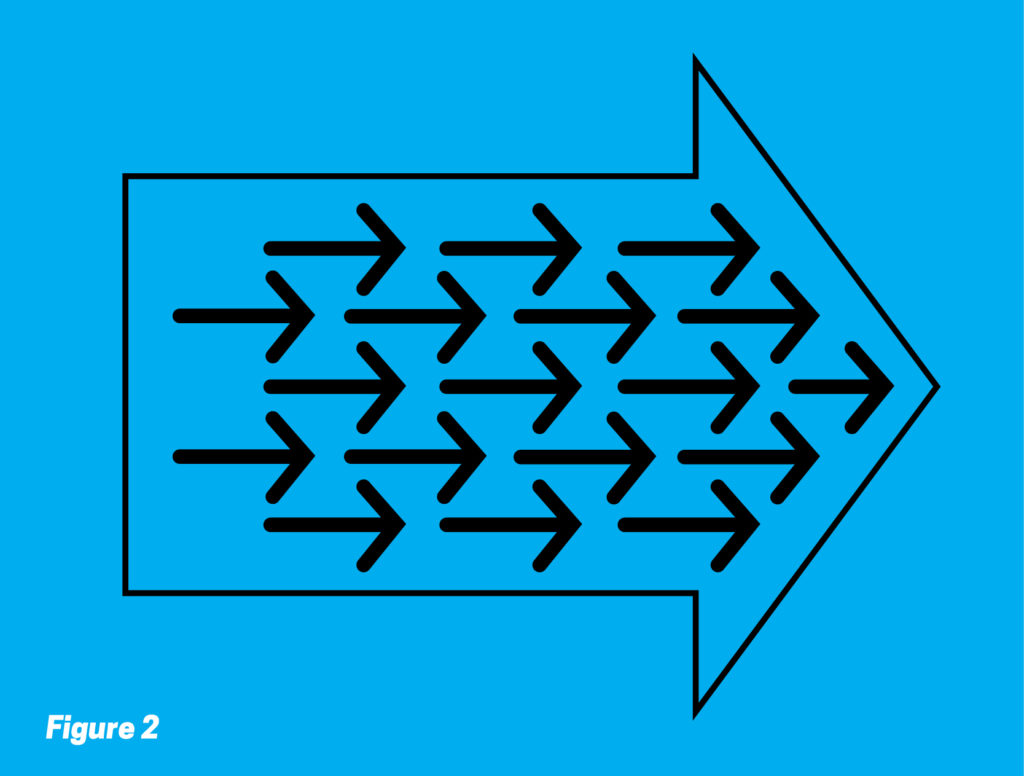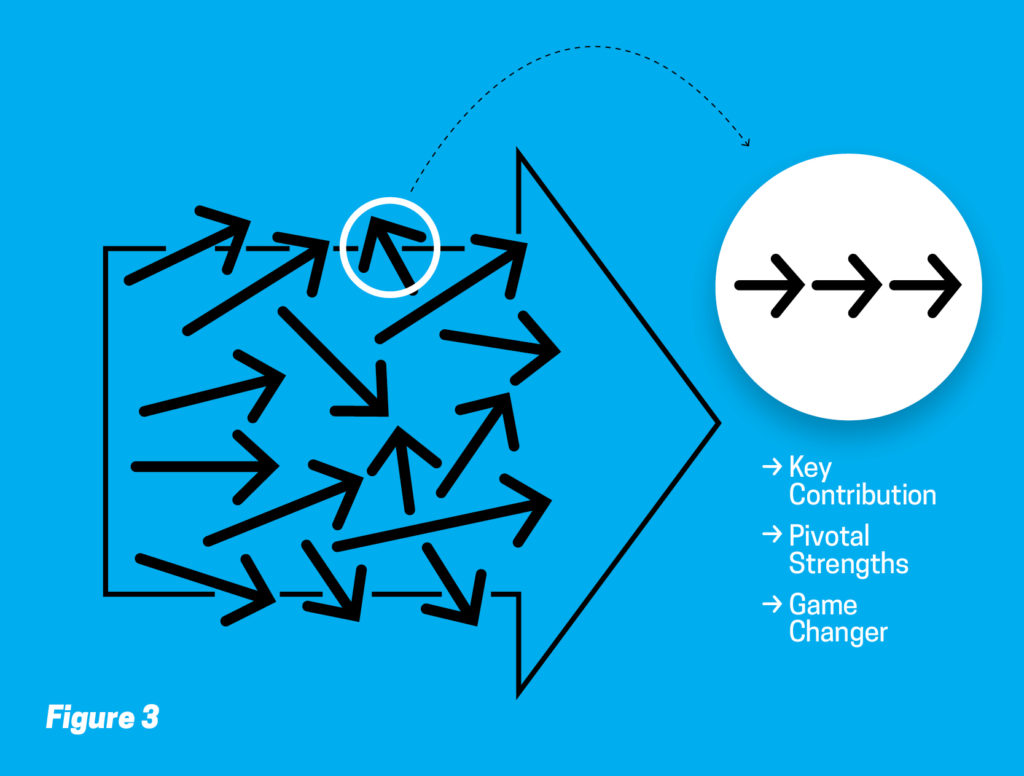The economy is about to reopen, but it won’t be business as usual. But if you can imagine your Big Arrow, you’ve mastered half the strategy for getting your organization back on track.
By Peter Bregman
“I’m not sure whether we have a leadership problem, or a team problem,” my client’s panicked call began. “But either way, we have a problem.”
John (not his real name) had reached out to me in hopes of finding a solution to his most pressing dilemma. Not that he was unqualified to solve it himself: He had started a technology company, grew it rapidly, and then sold it to a bigger company. After several years in a corporate environment, he left to take a leadership position at a midsize technology firm.
Given his experience in startup, fast growth, and established corporate environments, John had seen it all. And even he couldn’t tell who was responsible for his quandary: the leader or the team.
Sign up for the monthly TalentQ Newsletter, an essential roundup of news and insights that will help you make critical talent decisions.
I knew the answer, but I knew he wouldn’t like it. “It’s both,” I told him, because it’s near impossible to have one without the other. “They’re symbiotic. What’s the impact of the problem?”
John’s reply: “An amazing amount of wasted potential.”
His organization had ambitious goals, a clear strategy, and plenty of motivated workers. “But one plus one is not equaling three,” he said. “It’s not even equaling two. It’s more like one plus one equals one-half. People are tired, and our results don’t reflect the work everyone is putting in.”
I knew what John needed to hear—or rather, see. So I drew a quick picture and sent it his way. “What you have here,” I said, “is an alignment problem.”
Look at Figure 1. People start moving in pretty much the same direction. But add a decision here, an interpretation there, and throw in a disagreement or two for good measure, and you end up with a gaggle of people moving in multiple directions, sometimes—maybe even often—in opposition.
John begrudgingly admitted that he saw his people in those arrows. “But it’s strange,” he said, “because people work hard to get along. I think we sincerely care about one another as a group. No one is trying to get in another’s way.”
I knew exactly what he meant, and I bet you do, too. It’s counterintuitive, but when we try to get along with one another, we usually end up making the problem worse. In a misguided attempt to avoid conflict, we hunker down and work without the kind of coordination, alignment, and difficult conversations needed to make sure the collective impact of everyone’s individual efforts pays off in the bigger picture.
I told John that his people weren’t intentionally or strategically working against one another—but neither were they intentionally or strategically working with one another.
When everyone is legitimately busy working on a variety of important projects, their misalignment can slip by unnoticed. Which brings us to our double whammy: a leadership and a team problem.
“So what do we do?” John asked.
The first step is to get a clear understanding of what you’re aiming for. Naturally, I drew him another picture.

Figure 2 is your end-state. First, the individual arrows, which represent people and teams, are aligned within the boundaries, and following the direction, of a Big Arrow. (More on that in a moment.) Second, the productivity of each person is amplified, in part because they’re supported by the collective efforts of the group, and in part because the organization can afford to support clear alignment with deeper resources to support performance.
Ultimately, what you want is an organization led by powerful, secure, confident leaders who work together generously to achieve extraordinary things.
“Great,” John told me. “Looks beautiful … on paper.”
It’s not as hard as John—or you—may think. Actually, that’s not true. It is hard. But it’s not complicated. What’s hard is the discipline of following a process and the courage to show up with honesty, transparency, confidence, and humility. As for that process, here’s where the Big Arrow comes in.
The first step is to define your Big Arrow, which includes a measurable outcome and a behavior.
The outcome is derived from, but not the same as, the company’s strategy. A strategy has multiple elements to it. The Big Arrow is the one highly leverageable thing that would make the biggest difference to the success of the business.
The Big Arrow behavior articulates how everyone needs to show up, individually and collectively, to achieve the Big Arrow outcome. While it’s different for every company or team, typically it describes the kind of collaboration, listening, care, accountability, urgency, and transparency that will lead to powerful working relationships.
Once you define the Big Arrow, the next step is to identify the people in your organization who will drive it forward: the key contributors. These people are often relatively senior in the organization, but they don’t have to be. Neither do they have to be leaders, or even managers. They don’t even need to be the highest paid or most respected people. All they require is the capacity to make an important impact on the advancement of the Big Arrow.
Now that you’ve picked your key contributors, you’ll need to define their individual arrows. That is, each of their key contributions to the Big Arrow (an outcome they need to achieve); their pivotal strength as it relates to that key contribution; and their game changer, or the one thing they can work to improve to better make their key contribution.

See Figure 3. Each individual arrow creates the map for the key contributors to follow over the next 12 months. The key contribution is their main focus. Their objective is to leverage their pivotal strength, and address their game changer, to make their key contribution and move the Big Arrow vigorously forward. This map is their filter for action.
What’s important is that everyone knows everyone else’s individual arrows. If I know your key contribution, I can support you in making it. If I know your pivotal strength, I can lean on it, learn from it, and trust your capability in it. And if I know your game changer, I can support you, help you, and make up for any gaps you may have. We can work together as a team.
Collectively, our key contributions are precisely what we need to move the Big Arrow forward. If a specific key contribution is missing, then we may be missing a key contributor and may need to add to the team.
These individual arrows are critical, but they’re not enough. A map can show you the way, but it doesn’t help you walk the path. That’s where the next step comes in: coaching.
We use coaching to help your team make decisions, communicate, and take actions that leverage their strengths, address their game changer, and move them—and the business—forward by making their key contribution to the Big Arrow. This is a very different use of coaching than is traditional in most organizations. Typically, coaching is highly inefficient. It’s expensive, reserved for problem employees, and individually focused.
Within the Big Arrow process, we use coaching as a supportive resource to help your most important people make critical progress on the company’s most important work. It’s coaching at scale, where the coaches talk to one another and coordinate their work to impact individual performance and generate collective momentum.
But there’s something else that coordinated, scaled coaching can offer your business: key data. And a lot of it.
While coaches help individuals, they also collect data about trends and organizational obstacles getting in their way. The top leaders of the organization then use this data to cut through the noise and make specific changes and decisions to support their people in achieving the business outcomes of the Big Arrow.
I’m not talking about opinion surveys on satisfaction or engagement that you probably collect once a year from the entire employee population. This is specific, real-time, actionable data highlighting what’s getting in the way of your most important people collaborating on your most important work.
Armed with that data, leaders can make strategic decisions to boost productivity while coaches continue to help key contributors walk those paths. Pretty simple when you think about it, right? It’s all about laser focus and support.
John didn’t exactly think so—yet. “But what about across teams?” he challenged. “The alignment within our teams isn’t our biggest problem. It’s the alignment between our teams that’s slowing us down.”
Indeed, I’ve been seeing more and more of what John was describing: how people may work pretty well with one another within their silo, but not so well between silos. Fortunately, the fix is easy.
“Same process,” I said. “It’s just a bigger arrow.”
Want to align two teams? Define the Big Arrow in a way that reflects the overlap. What is the outcome they’re collaboratively trying to achieve? That’s your Big Arrow. And it requires the teams to work together to achieve it. The result: a team of leaders aligned, supported, and collectively working to achieve the organization’s most important work.
And that, I told John, is why it’s not important to know whether you have a leadership problem or a team problem. The solution is the same.
Peter Bregman is the CEO of Bregman Partners Inc., a company that helps senior leaders work in alignment to achieve their most important priorities. He’s also the author of several business books, including the bestseller 18 Minutes, and the host of the Bregman Leadership Podcast.


